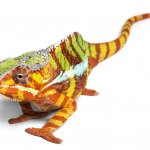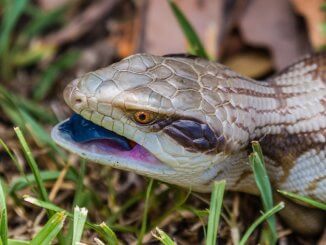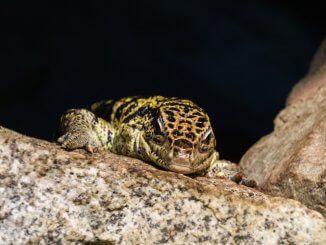Have you ever wanted to keep a rainbow-colored Chameleon?
The colorful Panther Chameleon is loved by many hobbyists for its color-changing abilities, vibrant color shades, and unique patterns.
These slow-moving lizards are one of the most popular pet chameleons in the world.
Despite their popularity, this large species of Chameleon is very difficult to care for in captivity and is not recommended for beginners.
They are not aggressive or difficult to handle but many of them struggle to live in captivity.
If you want to keep this colorful species, then keep reading to learn how to provide them with the best husbandry and where to buy them from…
Panther Chameleon Overview
The classification of a Panther Chameleon is Furcifer pardalis and they are sometimes called a “Jungle Chameleon”. They are native to the eastern and northern parts of Madagascar.
They are the most popular pet chameleon in the world because of their unique traits and vibrant color shades. Their rotating eyes, slow movements, and long tongue are only a few of the features that will capture your attention.
Thousands of Panther Chameleons were exported from Madagascar throughout the 1970s until their exportation was outlawed.
As well as being exported to the pet trade they also started disappearing due to deforestation in their natural habitat. You can now only purchase captive-bred Panther Chameleons.
Unfortunately many species of Chameleon do not adjust to life in captivity very well. Many die during shipping or shortly after their arrival due to stress and poor husbandry. Lizards that survive their first four weeks in captivity have a much higher chance of living another two or three years.
Males are harder than females and because of this are more expensive.
Many experienced keepers have successfully housed Chameleons in their homes for several years. However, if you are looking for your first pet reptile then you would be better looking for a leopard gecko or bearded dragon.
The habitat requirements for this species are very simple.
They need a large mesh cage with lots of space and branches to climb. They also like warm temperatures and high humidity to reflect their natural environment.
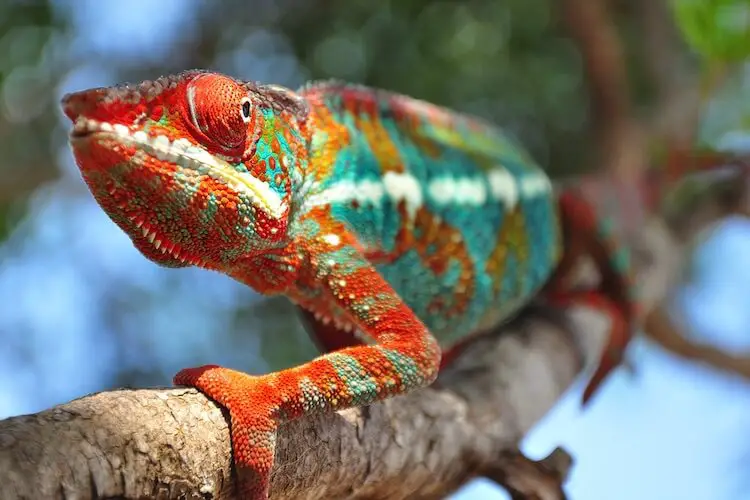
Interestingly, on their front feet, the two toes are on the outside and three on the inside, but that is reversed on their rear legs with three toes on the outside and two inside.
What We Like About Panther Chameleons
Pros
- Unique slow-moving mannerisms.
- Vibrant shades of color.
- Quick-moving tongue.
- Hardier than other chameleon species.
Cons
- Stress easily.
- Very difficult to breed
- Complicated husbandry requirements.
- Short natural life expectancy that is even shorter in captivity.
Species Appearance
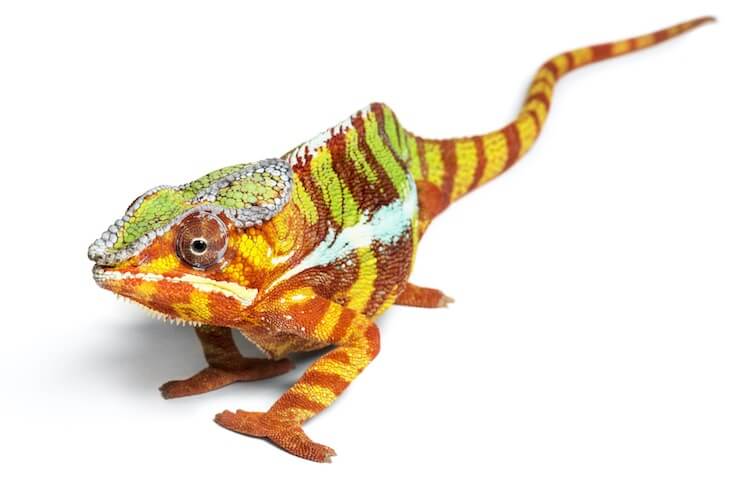
Panther Chameleons are very colorful and large lizards. They are easily identified by their:
- Unique patterns and colorful skin.
- Turret-shaped rotating eyes that help achieve 360-degree vision.
- Zygodactyl feet that help them climb branches.
They also have long tails that they use to hold branches with (i.e. prehensile tails).
Panther Chameleon Size
Panther Chameleons are larger than many other species of chameleon.
From Birth
As hatchlings, they are tiny and are just an inch in length at birth.
They quickly grow and reach sexual maturity at between four to seven months. They are fully grown by one-year-old.
Males are slightly larger than females.
A full-grown male adult has a body length of 12 to 20 inches and can weigh 140 to 220 grams.
Female Panther Chameleons
Females are slightly smaller measuring 8 to 14 inches in length and 100 grams in weight.
They are sexually dimorphic, meaning that there are differences between males and females. The visible differences are that males are larger and have more vibrant dark colors than females.
While there may not be obvious differences in anatomy, they do have different sets of sex chromosomes.
Panther Chameleon Colors
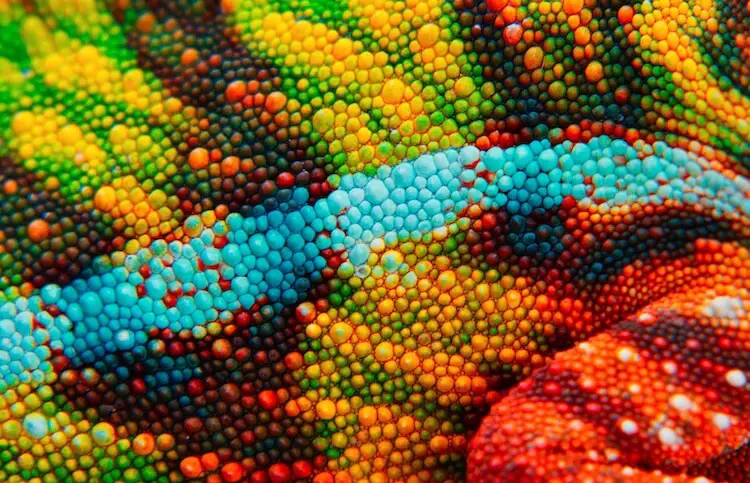
Skin color is one of the most unique features about this reptile.
Some species may display a rainbow of red, green, orange, and blue and others just one or two shades above or below those colors.
Red, green, and blue are the most popular base colors. It is possible for them to have shades of other colors such as orange and yellow.
Every Chameleon has bumpy skin and can show patterns of vertical stripes, spots, lateral horizontal stripes and even “tiger” stripes.
There are many different morph colors with the most popular being the Blue Bar Panther Chameleon (pictured below).
Panther Chameleon Care Sheet
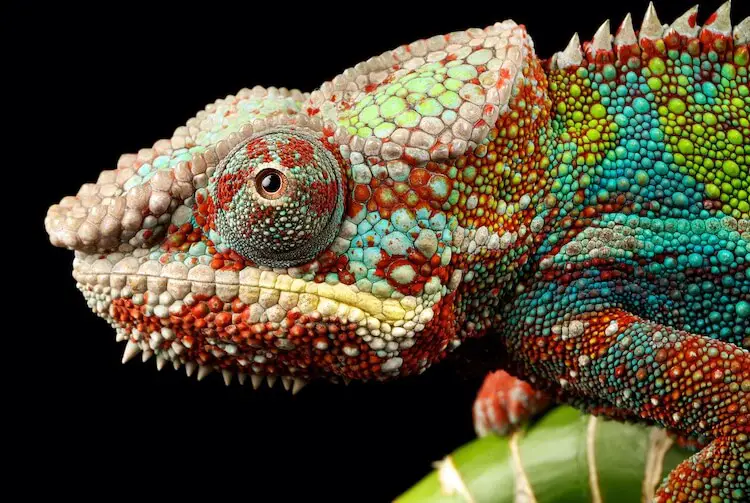
This reptile provides a great learning experience for someone looking for a challenge. Their husbandry and diet requirements can quickly become very complicated – especially if they become sick or stressed.
Panther Chameleon Diet
Very little is understood about their nutritional requirements. What is known is that this species is mainly an insectivore.
In the wild Panther Chameleons eat a wide variety of animals including crickets, mealworms, waxworms, grasshoppers, roaches, flies, bees, beetles, and other small insects. Large males may even consume small birds.
Many keepers do not have an issue with convincing their chameleon to eat in captivity.
You should feed 15 to 30 crickets four times a week. You can also feed wax worms or giant mealworms.
Any invertebrates you feed should not be larger than your chameleon’s head and should be gut-loaded.
When feeding your chameleon you can either put their food in a shallow dish or feed them by hand.
In the wild Panther Chameleons enjoy licking morning dewdrops and raindrops. You can encourage this behavior in captivity by misting their enclosure 2-4 times a day.
Alternatively, they are attracted to dripping water.
You can teach them to drink from a small water dish with slow-dripping water. To build a simple water drip system fill a plastic cup with water and poke a small hole in the bottom and fix it above the dish.
Supplements
Any invertebrates you feed should be dusted with calcium supplements.
One of the more complicated parts of a Panther Chameleon’s nutrition is their vitamin A and D intake and metabolism.
Vitamin A can be fed as a supplement or as vegetables. Feeding carrots, yams, or leafy greens is controversial because there is no evidence that feeding vegetables are any better than a supplement. However, it has been proven effective in other reptiles.
Vitamin D is a more complicated nutrient that is essential for their growth and development.
A vitamin D supplement should be fed to adults if they do not get adequate amounts of UVB light exposure from their habitat. It should not be fed to neonates, they should instead be fed micro crickets and drosophila flies.
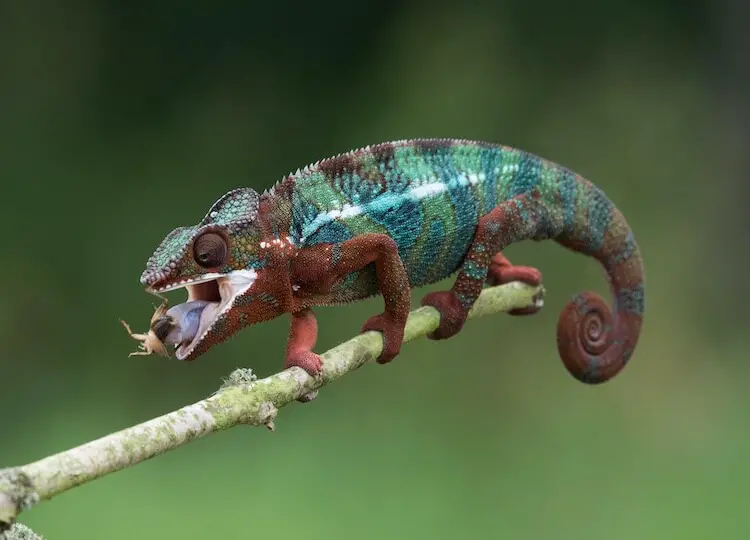
Lifespan & Health
The best way to keep your Panther Chameleon healthy is to provide a good habitat and routine husbandry in a low-stress environment.
They are not typically healthy when kept in captivity because they are highly susceptible to stress and environmental changes. Sometimes this stress can be too much for them and lead to death.
Females do not live very long in captivity and can die within months.
Males are hardier than females and can live as long as seven years. However, they typically live for two to three years.
The most common health problem is hypovitaminosis A. It can lead to blindness but is easily avoided by supplementing vitamin A in their diet.
Metabolic bone disease is also a common disease found among reptiles and can be avoided by dusting a calcium supplement onto insects before feeding.
Wild-caught chameleons are prone to having internal parasites. This should not be a problem for the Panther Chameleon as it is illegal to catch them in Madagascar.
Signs They Are Healthy
- Bright and vibrant colors.
- Regularly climbing branches.
- Tongue is quick-moving when eating.
- No obvious skin lesions or infection.
- Eyes move easily around the socket.
Sickness Symptoms
- Poor coloration.
- Thin and losing weight.
- Refusing to eat.
- Regurgitating food.
- Pale mucous membranes.
Panther Chameleon Habitat
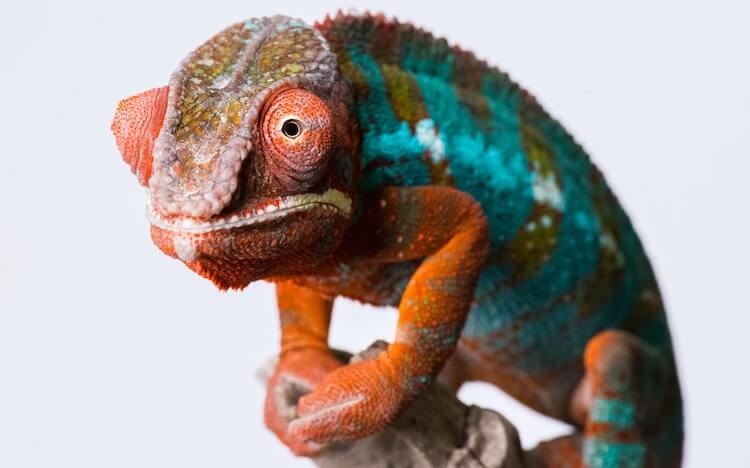
This reptile is native to northern Madagascar, an island located east of South Africa.
Panther Chameleons thrive in warm, humid climates with very little fluctuation in weather patterns or temperature.
In the wild, they live in short trees, shrubs, and bushes on the edges of larger forests.
Environmental changes cause Chameleons lots of stress so it is essential that you provide a habitat that mimics their natural one.
Panther Chameleon Cage Size
Chameleons need lots of space to be happy, including vertical space to climb. Females should be housed in an enclosure that is 40-gallons in size. Males need a larger habitat that is at least 50-gallons.
- Tank Type: wire mesh.
- Tank Size: 50-gallon.
- Lighting: fluorescent and UVB.
- Substrate: reptile carpet.
It is important their cage is made from wire mesh with a wooden or metal frame. The wire mesh should be coated in plastic to avoid rusting.
The holes in the mesh should be half an inch squared. This cage will allow for proper ventilation and keep them calm and relaxed. It will also provide a visible barrier to keep them in.
Avoid using aluminum or hardware cloth as it may damage their feet.
Unlike many reptiles, Chameleons should not be housed in a plastic or glass cage because they are not well ventilated and may lead to skin or eye infections. They can also become stressed if they see their own reflection in the glass.
Cage Setup
The top of their cage should be six feet off the ground so they are at eye level.
Heating And Lighting
Lighting requirements for a Panther Chameleon are often misunderstood.
Many keepers use a fluorescence lamp for lighting and seeing into their enclosure. Studies have shown that using lights that emit UVA waves is detrimental to their growth because it degrades vitamins and suppresses their appetite.
Panther Chameleons need UVB lighting.
The best method to provide UVB light to your reptile is by using a 40 watt UVB bulb. You Chameleon should be exposed to this light for 50 – 80 hours per week. You can also put them in natural sunlight for five hours a week.
Too much UVB exposure can cause cancer so make sure not to over-expose them. So ensure they have space to move away from their basking spot.
A Panther Chameleon has a very large range of ambient temperatures where it can remain healthy (i.e. thermoneutral zone).
Their enclosure can range from 65℉ to 90℉ with a basking area that is several degrees warmer. Tank temperature should be reduced by 10℉ at nighttime and it is best to use an under-tank heating pad.
Humidity
Humidity should be kept between 60% – 80% and can be increased by misting and putting live plants in their tank. This species is an avid climber and needs to have lots of plants and reptile furniture.
Furnishing
They are avid climbers and need to have lots of plants and reptile furniture.
You can use artificial plants and branches as they are easier to clean, but real branches and plants make for a better aesthetic and can reduce your Chameleon’s stress level. The best plants to use in their habitat are:
- Bonsai-trees
- Ivy
- Orchids
- Ferns
Plants should be removed if your lizard decides to eat them.
Substrate
The substrate requirements for a Panther Chameleon are very simple. Because crickets tend to hide under any substrate in their tank it is best to have none. Spot clean any uneaten crickets from their tank every day.
You can use a simple reptile carpet but they should not have any loose substrate such as sand or gravel as this leads to gastrointestinal impaction.
Typical Behavior
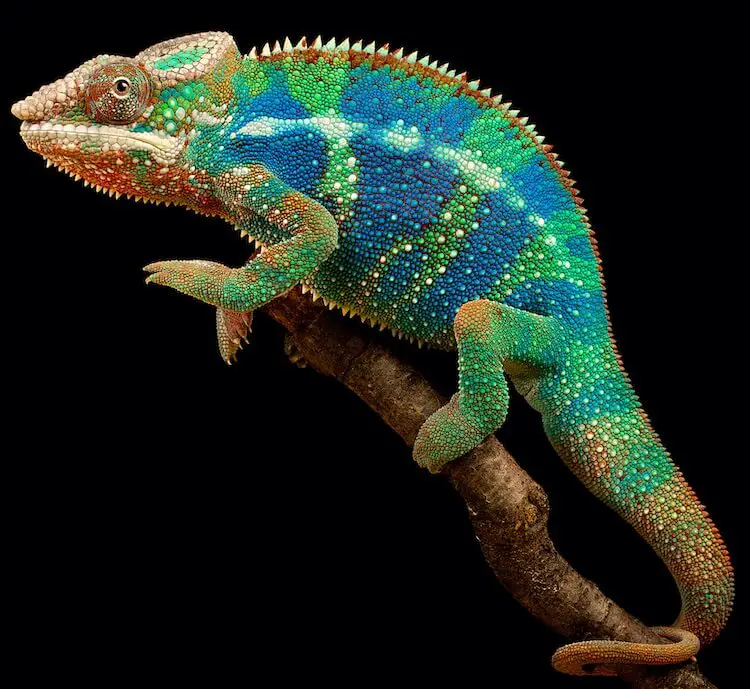
Panther Chameleons are one of the least studied reptiles.
What is known is they are diurnal and enjoy climbing.
They are also very slow-moving creatures and each step they take is deliberate. The fastest part of this lizard is their long tongue – it is frog-like and specialized for quickly snatching prey from the air or ground. It can be one to two times its own body length!
They are solitary animals and are very territorial. Because they are territorial they must live in their enclosure alone.
In their enclosure, they will likely be climbing on a branch or simply sitting on a branch.
Little is known about their forms of communication, except the classic change of color.
It is a common misconception that they change color to match their environment. They may darken and lighten depending on the natural light but their coloring doesn’t change with their surroundings. It has its color range from birth based on its particular species which helps camouflage them in the natural habitat for that species.
They do change color to signal:
- Sickness
- Attraction
- When females are carrying eggs (gravid) they go mainly dark brown or black
- Two males together being territorial
Do Panther Chameleons Like To Be Held?
No, despite them being docile, handling stresses them greatly. Frequent handling will increase its stress level and cause health problems.
You should only handle a Panther Chameleon if you absolutely must (e.g. moving enclosures).
If you have to handle them, let them grip you as you hold out a flat and stable hand instead of wrapping any of your fingers or arms around them. If their toes feel sharp, then wear gloves.
Wash your hands before and after handling to reduce the risk of catching a disease.
Where To Buy A Panther Chameleon
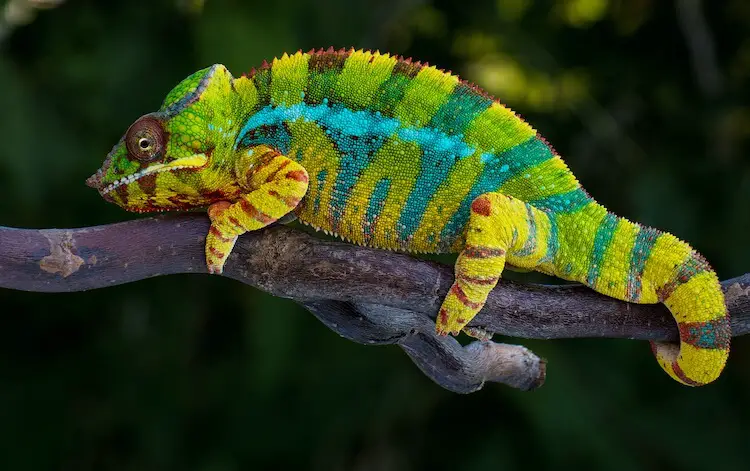
Panther Chameleons should only be purchased captive-bred from a reputable breeder. It has been illegal to export this species since the 1970s.
Wild-caught lizards are prone to diseases and stress when in captivity. Chameleons especially have a very difficult time adapting to life in captivity.
Captive-bred lizards are better acclimated to a caged environment.
How Much Does a Panther Chameleon Cost?
They normally cost between $150 and $600 with their price heavily dependent on color, morph and breeder.
Panther Chameleons breed more readily in captivity than other species of chameleon.
Copulation lasts for about 10-45 minutes and may be repeated several times over the course of a few days. When pregnancy occurs the female will darken in color.
Females will lay about 10-40 eggs per clutch though it is likely that many will die in the process.
You should keep a baby chameleon at 77℉ – 80℉ and at least 60% humidity.
They can be housed in a small aquarium or clear plastic container with a screen top and can eat micro crickets or drosophila flies sized smaller than their head.
Panther Chameleon Facts
| Common Name | Jungle Chameleon |
|---|---|
| Scientific Name | Furcifer pardalis |
| Price | $150 – $500 |
| Size | 8 – 20 inches |
| Lifespan | 2 to 7 years |
| Diet | Insectivorous |
| Tank Size | Minimum 50-gallon |
| Humidity & Temperature | Daytime temperature: 65℉ – 90℉ Humidity: 60% – 80% |
| Popular Alternatives | Veiled Chameleon, Jackson’s Chameleon |
Summary
Panther Chameleons are one of the most unique and fascinating reptiles.
Many herpetologists love them for their vibrant colors and the challenge they pose to keep them healthy.
They are not good pets for beginners who cannot provide them with their meticulous and sometimes difficult care.
If you are looking for a beginner-friendly reptile many owners choose a Crested Gecko.
Do you have any Panther Chameleon experiences? Tell us below.







